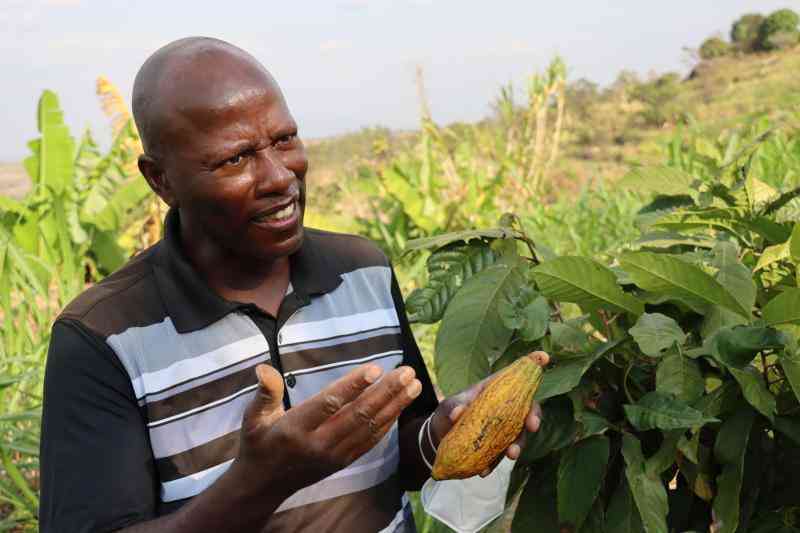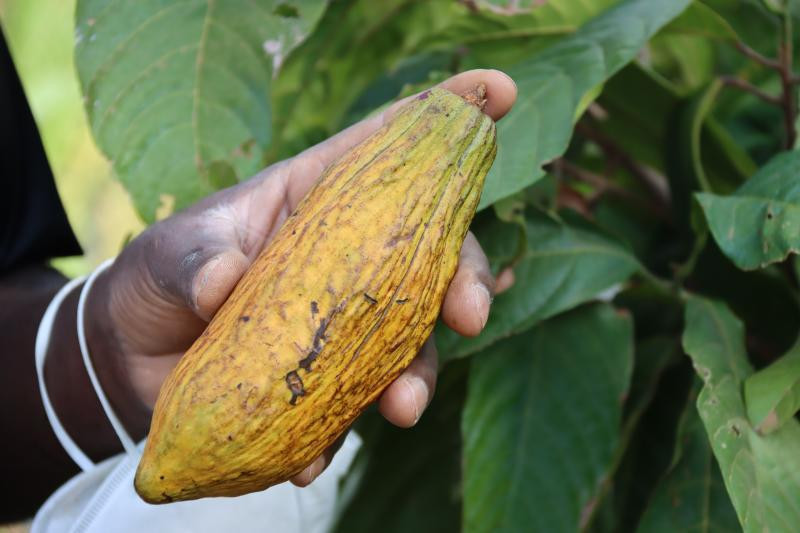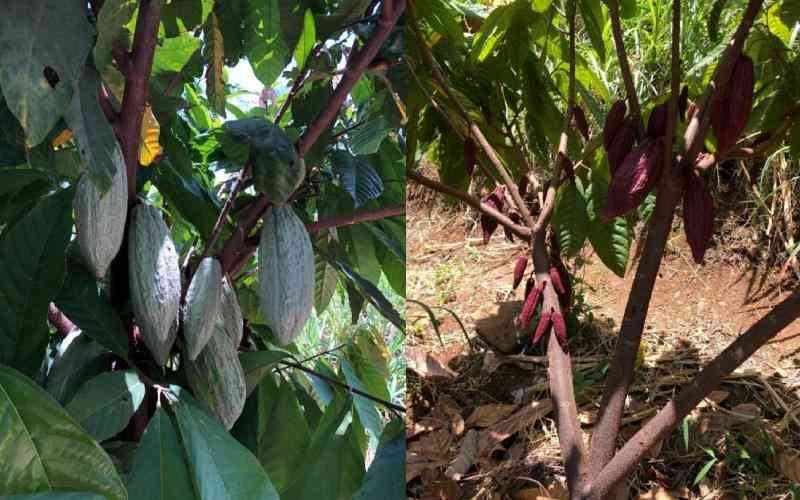
Antony Mugambi shows mature cocoa pods in his two-acre farm. [Phares Mutembei, Standard]
Four years ago, Antony Mugambi, an IT expert based in Meru County, embarked on a journey that would transform both his life and the environment around him. His venture into cacao farming, a crop traditionally associated with West Africa, has proven to be not just a personal triumph but a testament to the untapped agricultural potential in Kenya. Today, Mugambi’s cacao farm is a symbol of innovation and resilience, marrying economic success with climate action in a way that few could have imagined.
Mugambi’s journey began in 2019 when he planted his first cacao trees on a small parcel of his 40-acre farm in Kiagu, Central Imenti. Initially, his neighbours were skeptical, as the region is traditionally known for coffee farming. However, Mugambi’s vision was clear: he saw cacao not just as a potential source of income but as a crop that could contribute to reforestation efforts and help combat climate change. “The cacao tree is not only an income-generating plant; it is also a significant contributor to afforestation,” Mugambi explains. “Earning from it while contributing to climate change action is incredibly fulfilling.”
Cacao, the plant from which cocoa and chocolate are derived, thrives in tropical climates, and Central Imenti’s conditions have proven ideal. The similarities in climate between Meru and cacao-growing regions in West Africa meant that Mugambi’s crop quickly flourished. “The climatic conditions for cacao are very similar to those for coffee,” he notes. “While my neighbors were initially pessimistic when I planted my original cacao, they are now amazed by the success I’ve achieved.”

Cocoa pods in Antony Mugambi's two-acre farm in Kiagu in Central Imenti, Meru County. Mugambi makes craft chocolate from his cocoa harvests as he plans to dedicate 20 acres out of his 40 acre farm for cocoa plants. [Phares Mutembei, Standard]
Mugambi’s success has not gone unnoticed. Wellington Ndaka, the Kenya Forest Service (KFS) Conservator for Meru, acknowledges the potential of cacao as an afforestation tree. “Cacao can be an important tree in our efforts to increase forest cover,” Ndaka says, pointing to the crop’s ability to thrive in Meru’s environment. This sentiment is echoed by Dr Mithika Mwenda, Executive Director of the Pan Africa Climate Justice Alliance (PACJA), who has also introduced bamboo planting in Meru communities as part of climate change mitigation efforts. “Cacao can certainly contribute to our reforestation goals while providing farmers with a sustainable income,” Dr Mwenda adds.
The dual benefits of cacao — economic and environmental — are what drive Mugambi’s passion for the crop. On his thriving two-acre cacao farm, he not only reaps financial rewards but also serves as a model for other farmers looking to diversify their crops and income sources.
“A kilo of cacao beans fetches more than Sh1,000, which is a sharp contrast to coffee prices, with a kilo currently earning a farmer less than Sh100,” Mugambi points out. This stark difference in profitability has convinced him to expand his cacao cultivation, with plans to dedicate up to 20 acres of his farm to the crop.
Mugambi’s journey into cacao farming was not a decision made lightly. An IT expert by profession, he conducted extensive research on cacao’s agronomy before committing to the venture.

Cocoa pods in Antony Mugambi's two-acre farm. [Phares Mutembei, Standard]
His initial seedlings were sourced from friends in Tanzania and the Kenya Agricultural and Livestock Research Organisation (Kalro), ensuring that he had the best possible start. “The climate in this area is good for cocoa production, with its high temperatures,” he explains, highlighting the importance of local climate in his decision-making process.
One of the most compelling aspects of cacao farming for Mugambi is the plant’s ability to produce fruit year-round. “Cacao grows fruits throughout the year. It takes about five months for a fruit bud to mature,” he says. This continuous production cycle ensures a steady income stream, unlike many other crops that have specific harvesting seasons.
With his cacao farm now well-established, Mugambi has taken his venture a step further by exploring value addition. He has set up a small craft chocolate manufacturing facility, where he transforms his cacao beans into chocolate. His ultimate goal is to establish a larger industry after further propagation of his cacao plants. “I started farming cacao in 2019, and when I harvest it, I make chocolate,” he says, underscoring the profitability and versatility of the crop.
Mugambi’s success has also had a ripple effect on the local community. He is now a source of inspiration for other farmers, particularly those looking to diversify their crops in the face of declining coffee prices.
“I want to inspire other farmers to take up cacao as a diversification and food security measure,” he says. Mugambi has been actively educating his neighbors and other local farmers about the benefits of cacao farming, emphasising its potential to uplift families and contribute to environmental conservation.
Moreover, Mugambi’s cacao farming efforts are part of a broader strategy to combat climate change through agroforestry. By planting cacao trees, which provide good ground cover and contribute to soil conservation, he is helping to create a microclimate that can mitigate some of the adverse effects of climate change.
“Creating a forest with cacao plants is a way to mitigate climate change,” he argues. “The cacao plant can be a very good agroforestry product that not only provides fruit but also contributes to reforestation efforts.”
As Mugambi looks to the future, he is focused on expanding his farm and scaling up his chocolate production. He is also keen to continue sharing his knowledge with others, particularly the youth, who he believes have the potential to drive Kenya’s agricultural sector forward. “The future is bright for cacao farming in Kenya, especially for young people who are willing to embrace it,” he says.
In the end, Antony Mugambi’s cacao farm stands as a testament to what can be achieved when innovation meets dedication. His journey from IT expert to cacao farmer is not just a personal victory but a beacon of hope for sustainable agriculture in Kenya. By turning a passion for cacao into a thriving business, Mugambi has not only secured his own future but is also contributing to the global fight against climate change — one cacao tree at a time.
 The Standard Group Plc is a multi-media organization with investments in media
platforms spanning newspaper print
operations, television, radio broadcasting, digital and online services. The
Standard Group is recognized as a
leading multi-media house in Kenya with a key influence in matters of national and
international interest.
The Standard Group Plc is a multi-media organization with investments in media
platforms spanning newspaper print
operations, television, radio broadcasting, digital and online services. The
Standard Group is recognized as a
leading multi-media house in Kenya with a key influence in matters of national and
international interest.



